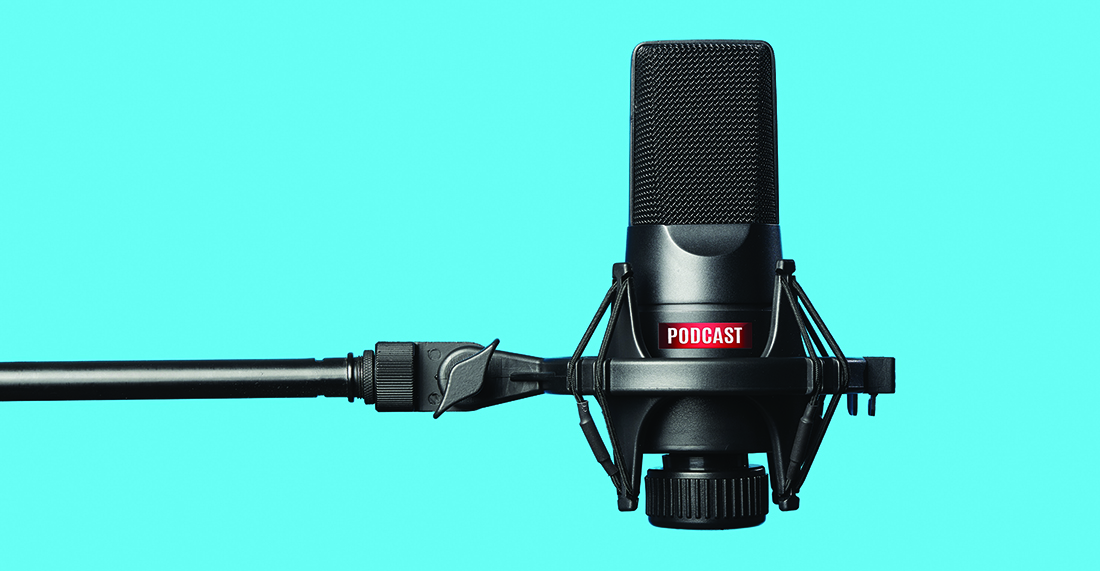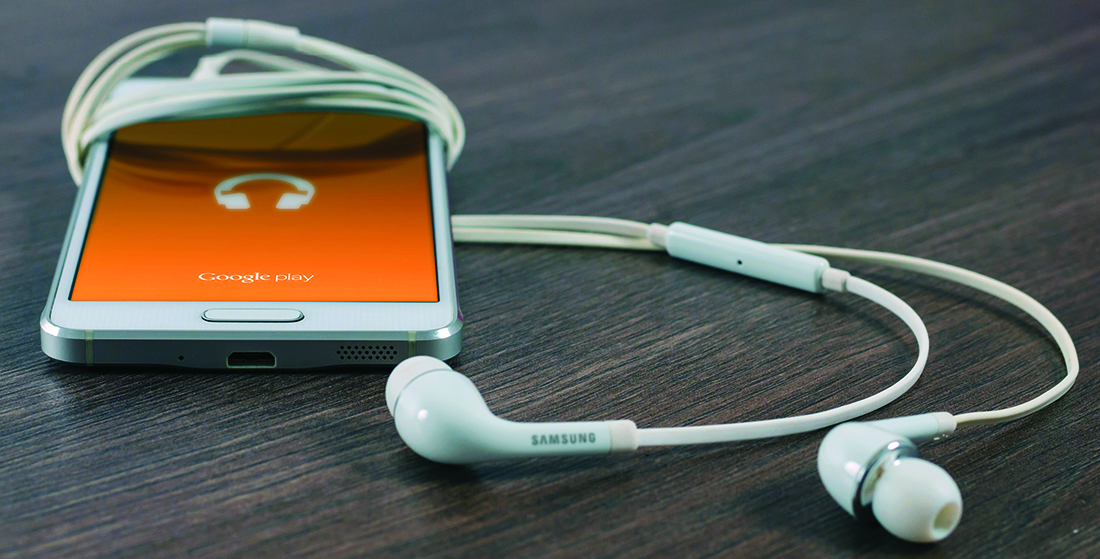Take a look around next time you’re riding public transportation, on a plane, or out on your city running trail. Chances are you’ll see people “plugged in” with earbuds listening to something on their phone. They may be listening to music, but perhaps they are listening to podcasts.
 With the growth of smart phones making podcasts more accessible, podcasts are now more popular than blogs and, according to Edison Research, in 2018, 44% of Americans twelve and older have listened to a podcast. While telling and listening to stories is older than the radio, today the growth of podcasts means that more people get their news, entertainment, education, and more by listening to podcasts.
With the growth of smart phones making podcasts more accessible, podcasts are now more popular than blogs and, according to Edison Research, in 2018, 44% of Americans twelve and older have listened to a podcast. While telling and listening to stories is older than the radio, today the growth of podcasts means that more people get their news, entertainment, education, and more by listening to podcasts.
As insights professionals, we can use podcasts in many ways in our research to both uncover and deliver insights in this popular format, bringing new excitement to our research outcomes. In fact, we can use podcasts throughout our research process from exploration to study design to delivery.
Exploration
Because the format is easy and inexpensive to produce, there are endless topics to explore in podcasts. Dig around and you’ll see that there is a podcast for nearly every special interest, hobby, profession, and sport. This is a huge opportunity for researchers as we dig in to a new topic or target audience. We can look to podcasts to help us with our “pre-work” to understand the terminology used among professionals in an industry or to uncover key themes to explore further in our interviews. We can even use some of the stories shared as secondary research sources for our findings.
For example, many people living with medical conditions create podcasts to share their stories to connect with others with the condition, share research available, or learn more about ways to manage life with the condition. In addition, they may interview doctors or other patients with this condition—why not use these podcasts to get a baseline understanding of the issue before you even write your discussion guide? You may even use these patient stories as your first insights on your journey for more. Through this exploration, you might discover shorthand ways they talk about their condition and uncover other issues that you perhaps planned to explore but now recognize are not as important after all.
Another way you might use podcasts for discovery is to connect with potential research participants. When you’re searching for that needle-in-a-haystack recruit, consider looking at podcasts. The show hosts and guests often offer their contact information through the show website. They want to connect with their listeners, so you’ll find biographies and contact information through many of these shows. As a bonus, by listening to the show ahead of reaching out, you already know that they pass your qualifications and articulation questions.
Design
One exciting feature of podcasts that keep listeners tuning in is the new and creative approaches many producers take for gathering insights through different interview styles and story formats. If you’re looking for inspiration for a new creative way to tell a story, check out some popular podcasts.
Some of my favorites take different approaches to interviewing that you might experiment with in your next focus group or research study. Like StoryCorps, that takes two or three people who have a shared experience to interview each other without a moderator. Or, REI’s Take it from Me that asks outdoor professionals to be interviewed by another pro from a different field, but on the next episode, the interviewee becomes the interviewer with
a third professional. Then there is Beautiful Anonymous that allows the anonymous guest to drive the conversation. While I don’t anticipate your client allowing you to conduct an interview without a discussion guide, just listening to Chris Gethard’s authentic empathy when interviewing strangers will make you a better listener and researcher.
Other shows present stories in unique formats that we may also use for inspiration. Award-winning RadioDiaries tells stories without a narrator to keep the focus on the subject of the story. Shows like This American Life or a short-run series called UnErased take a theme and explore that theme through different, often unexpected, points of view. My current favorite show, Everything is Alive, is a quirky and creative show where the host “interviews inanimate objects.” What does that mean? It’s simply a projective technique—the same thing we do when we ask participants to write a Dear John letter to the brand they are breaking up with or put all the competing brands into a party scenario, but it is performed by actors to entertain.
When we step back away from a format of PowerPoint slides and into “storytelling” we can find inspiration from shows that know how to tell a story that is impactful and memorable.
Delivery
Finally, look to podcasts as an opportunity to deliver engaging and unique deliverables. Many clients are looking for new ways to present insights that can be shared across teams instead of another Power-Point deck. Consider giving your clients the insights they need in an audio report in the style of a podcast. They can listen on the go, listen while taking a walk around the office, or listen at their desk.
There are many advantages of presenting audio only versus a written or video report.
- Audio is easy to collect. Participants are less self-conscious than when recording video and there are no concerns about poor lighting or other quality issues.
- Emotional pauses, sighs, and tears can be more impactful when listening to audio only.
- Using audio only gives a layer of privacy back to the respondents on more sensitive topics.
- We remove visual bias with audio only. Have you ever had a client sitting in the backroom disregard a participant because of the way they looked? That participant might have some great things to say, so give them the chance to share their story and allow the client to listen without judgment.
- Studies show that audio is more memorable because the listener develops an image in their mind while listening. This creates more connections in the brain and the listener becomes more invested in the story.
Even if you’re working with quantitative data, you can present a story in audio format. Listen to the news on the radio and you’ll find many stories that present numbers and data from research studies. Journalists often interview researchers to describe the key findings and the important takeaways of complicated research studies. We, too, can report like journalists translating detailed research into the important takeaways.
I’m often asked, what does a podcast deliverable sound like? How is it presented? Just like most popular, publicly-available podcasts the “show” begins with an introduction and some intro/outro music. From there, the formats can vary to include styles such as:
- A seven- to ten-minute executive summary report that describes the key findings interspersed with audio quotes from interviews with the actual voices of research participants.
- Persona profiles that describe the experience of the persona with voices of people who represent that persona.
- Diary updates for an ongoing study without a narrator to give teams a glimpse into a day in the life.
- Longer reports that are told over several episodes, like a serialized narrative.
Who can benefit from a podcast deliverable?
- Busy executives who need the brief “elevator pitch” version of the research that gives them what they need to know to make decisions.
- Team members who commute or travel and need to download the key findings before going into a meeting.
- Project stakeholders who don’t need the nitty-gritty details of the data, but only need the high-level information that impacts their work.
- Sales members who need to be refreshed on the experience of the customer before walking into a sales call.
- Product development teams or creative teams who need to hear the voice of the consumer (literally) or profile of a persona before they design a new package, product, or experience.
Of course, for our purposes a research podcast isn’t a publicly available show downloaded from iTunes; it is simply an audio report privately shared with clients and presented in the style of a podcast. It can be a simple mp3 file or it can be inserted into a larger presentation. See examples on our website, www.NimbleMR.com. We’ve also created password-protected websites where clients can download or listen to the podcast as well as explore a media gallery or read key details from the reports. This creates a central place for the research to live and an opportunity to expand how teams can interact with the findings.
While some were unsure or reluctant at first, clients who have received podcast deliverables respond overwhelmingly with positive surprise. Hearing the voices of the target audiences and getting the key insights in a storytelling format is fresh and inspiring. Some clients who receive only the mp3 file enjoy getting it without “all the extra stuff,” and clients who received a website deliverable enjoy interacting with the research media in a modern format and not flipping through another one-dimensional deck.
If you’re not already a podcast listener, tap on your podcast app on your phone and begin exploring. Pretty soon, you’ll see how podcasts are qualitative research and how we can use this popular medium to bring our insights to life.
Tips for Producing Research Podcasts
Plan Ahead – Before you gather your insights, have a plan for capturing good audio. Whether it’s a focus group or one-on-one interview, plan for a quiet space and good microphone techniques (no hitting or moving away from the microphone).
Capture Audio Throughout the Research – Are you conducting an online qualitative study? Capture audio instead of video responses. One-on-one interviews via web platforms can be a source of great audio.
Get Creative – Are you presenting results of a survey with complicated analytics? Take a cue from radio reports on scientific studies. Interview your analytics director to explain what it all means. Have someone who fits the demographic profile of your open-ended responses read the responses for illustrative purposes.
Hire Help – Yes, you can edit the audio yourself, but consider hiring a professional podcast producer and/or voice-over professional to get that podcast-quality sound.



2 Trackbacks / Pingbacks